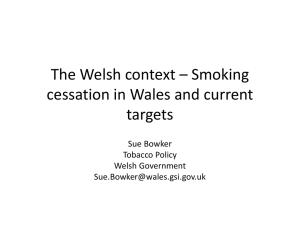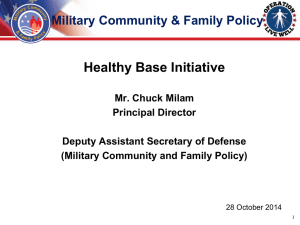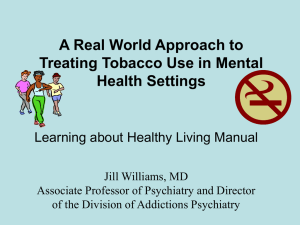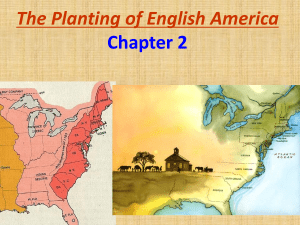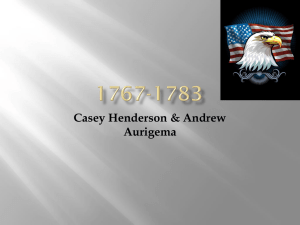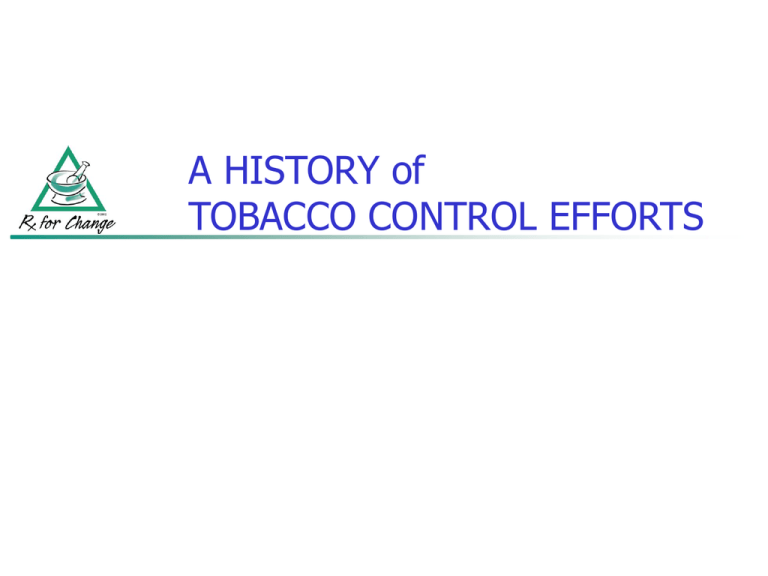
A HISTORY of
TOBACCO CONTROL EFFORTS
UNDERSTANDING the ROLE of
TOBACCO in the NEW WORLD
Tobacco use originated in the Americas and was exported
worldwide. Once tobacco became a popular crop throughout
the world, it was taxed heavily by the British and was one of
the economic causes of the U.S. Revolutionary War.
In 1770, 50% of British colonists earned their living from
tobacco production; wages were often paid with tobacco.
Tobacco was used as currency in and around Virginia for
nearly 200 years; it was called “country pay” or “country
money.”
UNDERSTANDING the ROLE of
TOBACCO in the NEW WORLD (cont’d)
The invention of the rolling machine in 1884 dramatically
increased the production of cigarettes and lowered their
cost, leading to a tremendous rise in consumption.
General John J. Pershing, commander of American forces in
France in 1918, was quoted as saying, “You ask me what we
need to win this war. I answer tobacco as much as bullets.”
From 1895 to 1905, the American Tobacco Company was
the second largest corporation in the United States.
As part of the war effort, U.S. president Franklin Roosevelt
made tobacco a protected crop. Cigarettes were included in
soldiers’ rations. Tobacco companies sent millions of free
cigarettes to troops.
A MOVEMENT with a LONG
HISTORY
In some countries, consequences for
tobacco use could be as severe as
execution or mutilation.
In the U.S., the anti-smoking movement
arose out of the temperance movement
around the 1830s.
A MOVEMENT with a LONG
HISTORY (cont’d)
In 1964 the first Surgeon General’s Report on
Smoking or Health was published, concluding
that “cigarette smoking is a cause of lung
cancer in men, and a suspected cause in
women.”
The health impact of tobacco gave rise to a
new movement that sought both to reduce the
ill effects on smokers and to protect the health
of nonsmokers.
TRENDS in ADULT CIGARETTE
CONSUMPTION—U.S., 1900–2005
Annual adult per-capita cigarette consumption and major smoking and health events
1964 Surgeon
General’s Report
Number of cigarettes
5,000
End of WW II
4,000
3,000
2,000
Broadcast
ad ban
Master
Settlement
Agreement;
California
first state to
enact ban on
smoking in
bars
Marketing
of filtered
cigarettes
U.S. entry into
WW I
1,000
Great Depression
First modern
reports linking
smoking and
cancer
Nonsmokers’
rights movement
begins
Cigarette
price drop
Federal cigarette
tax doubles
20 states
have > $1
pack tax
0
1900 1910 1920 1930 1940 1950 1960 1970 1980 1990 2000
Year
Centers for Disease Control and Prevention. (1999). MMWR 48:986–993.
Per-capita updates from U.S. Department of Agriculture, provided by the American Cancer Society.
GEOGRAPHIC DIFFERENCES
in SMOKING
Overall statewide smoking rate
30%
25%
20%
15%
10%
5%
0%
UT
CA
MA
U.S.
Avg
KY
Many people in Utah
have a religious and
cultural prohibition
against tobacco.
California and
Massachusetts have
active, public tobacco
control programs.
Kentucky is a prime
tobacco-producing
state.
PROJECTED DEATHS DUE to
TOBACCO USE: 21st CENTURY
Millions of deaths
500
400
300
200
100
0
2000-2025
2025-2050
2050-2100
Peto R. (2000). 11th World Conference on Tobacco or Health, Chicago, IL, August.
HOW DOES
TOBACCO CONTROL WORK?
Combine prevention and treatment
to reduce morbidity and mortality
Utilize multiple strategies from
multiple disciplines to accomplish a
single goal
COMPREHENSIVE TOBACCO
CONTROL PROGRAMS WORK
It has been well established that comprehensive
tobacco control programs can effectively reduce
Tobacco consumption
Tobacco-use prevalence
Tobacco-related disease
WHAT ARE TOBACCO
CONTROL STRATEGIES?
Efforts to curb the availability of tobacco products
Efforts to curb the use of tobacco products
Efforts to educate about the harms of tobacco products
and the tobacco industry
Efforts to reduce exposure to tobacco smoke in public
places
Monitoring of tobacco distribution and use
Examination of tobacco industry practices
OTHER TOBACCO CONTROL
STRATEGIES: LITIGATION
In recent years, tobacco control professionals have
supported lawsuits against the tobacco industry to
recover damages and force a change in corporate
behavior.
Successful cases brought on behalf of individuals
exposed to second-hand smoke produce dual benefits
for public health:
Paving the way for other nonsmoking litigants to succeed in their
cases
Persuading business owners and others to voluntarily make their
facilities 100% smoke-free
OTHER TOBACCO CONTROL
STRATEGIES: REGULATION
Comprehensive regulation of the
tobacco industry
Workplace smoking bans to
reduce total cigarette
consumption
A BIG STEP for TOBACCO CONTROL:
SMOKE-FREE WORKPLACE LAWS
Perhaps our
most significant
progress in
recent years
is the
establishment of
smoke-free
workplace laws.
Smoke-free offices, restaurants, and bars:
California, Colorado, Connecticut, Delaware,
Hawaii, Maine, Massachusetts, New Jersey, New York, Rhode Island, Vermont, Washington
Smoke-free offices and restaurants:
Arkansas, District of Columbia (bars in 2007), Florida,
Georgia, Idaho, Louisiana, Montana (bars in 2009), Nevada, North Dakota, Utah (bars in 2009)
Smoke-free offices:
Maryland, South Dakota
Data current as of November 9, 2006.
PUBLIC AWARENESS CAMPAIGNS
World No Tobacco Day –
every May 31
Great American Smokeout –
held each November
American Cancer Society’s Great
American Smokeout, circa 1969.
ANTI-TOBACCO MEDIA MESSAGES
The media can be used to
increase the public’s
awareness of the health risks
associated with tobacco use.
An INTERNATIONAL TOBACCO
CONTROL TREATY
The Framework Convention on Tobacco Control
(FCTC) is an international treaty—the first legal
instrument designed to reduce tobacco-related deaths
and disease around the world.
Key areas addressed by the treaty:
Advertising, sponsorship, and promotion
Protection from exposure to tobacco smoke
Illicit trade in tobacco products
Packaging and labeling of tobacco products
TOBACCO WARNING LABELS:
Do They Work?
An ongoing international research study
is examining the impact of different types
and sizes of warning labels on cigarette
packages in four countries: Australia,
Canada, the United Kingdom, and the
United States.
The researchers are examining whether
larger and more graphic warning labels
affect smokers’ perceptions of risk from
smoking and thus their intention to quit
and their behavior regarding quitting.
ITC Project, K. Michael Cummings,
Roswell Park Cancer Institute
TOBACCO WARNING LABELS:
Do They Work? (cont’d)
U.K.
Canada
Labeling as of May 2003
Australia
U.S.
Images courtesy of K. Michael Cummings / Roswell Park Cancer Institute
TOBACCO WARNING LABELS:
Do They Work? (cont’d)
Relationships between label-specific variables and quitting*
Labels make
smokers think
about risks
Quit attempt
Successful
quit attempt
Smokers who reported that the labels made them more likely to
think about risks of smoking were
— More likely to attempt to quit
(OR = 1.14)
— More likely to successfully quit
(OR = 1.89)
*Controlling for gender, age, income, education, ethnicity, prior quit attempts, and intentions to quit.
TOBACCO WARNING LABELS:
Do They Work? (cont’d)
More prominent package warning
labels are effective in….
Increasing awareness of health risks
Promoting quit attempts
Increasing quit success
Graphic warnings are more effective
than text warnings.
Images courtesy of K. Michael Cummings / Roswell Park Cancer Institute
LIMITATIONS on TOBACCO
CONTROL
Many tobacco users believe they have a legal and
ethical right to use tobacco if they choose to do so.
Even the most effective strategies do not reach all
tobacco users:
The least dependent tobacco users are typically
the first to reduce or quit tobacco use in response to
tobacco control efforts.
The most dependent users might never quit.
PUBLIC HEALTH versus
“BIG TOBACCO”
The biggest opponent to tobacco
control efforts is the tobacco
industry itself.
In the U.S., for every $1 spent on tobacco prevention,
the tobacco industry spends $28 to market its products.
TOBACCO INDUSTRY
ADVERTISING
$15.15 billion spent in the U.S. in 2003
Billions of dollars spent
21.5% increase over 2002 figures
35.0% increase over 2001 figures
15
10
5
0
1970
1997
1998
1999
2000
2001
2002
2003
Year
Federal Trade Commission. (2005). Cigarette Report for 2003.
TOBACCO INDUSTRY TACTICS
TARGET KIDS
One of the tobacco industry’s new tactics in targeting kids is the
introduction of candy-flavored cigarettes and smokeless tobacco.
Images courtesy of the Campaign for Tobacco-Free Kids.
All rights reserved. www.tobaccofreekids.org
TOBACCO INDUSTRY TACTICS
TARGET KIDS (cont’d)
Motion pictures are another communication channel of
the tobacco industry, especially when it comes to
influencing young, new viewers/customers.
92% of the top 10 grossing PG-13 films in theaters
between July and October 2002 included tobacco.
2 out of 3 tobacco shots in the top 50 movies from
April 2000 to March 2001 were in G, PG, or PG-13
movies.
SmokeFreeMovies project developed by Professor Stanton Glantz
at the University of California, San Francisco
TOBACCO INDUSTRY TACTICS
TARGET KIDS (cont’d)
Glantz et al. (2004). Am J Public Health 94:261–263.
Incidents per hour
15
Random
sample of
movies
10
5
0
1950
1980-1982
2002
Year
Parental restriction from watching R-rated movies predicts lower risk of trying
smoking among youth (Sargent et al., 2004).
WHY TOBACCO CONTROL
EFFORTS ARE SO IMPORTANT
“Four million unnecessary deaths per year,
11,000 every day. It is rare, if not
impossible, to find examples in history that
match tobacco’s programmed trail of death
and destruction. I use the word ‘programmed’
carefully.
A cigarette is the only consumer product
which when used as directed kills its
consumer.”
Dr. Gro Harlem Brundtland, Director-General Emeritus,
World Health Organization, 1998.
CDC’s BEST PRACTICES:
Recommendations for Comprehensive
Tobacco Control Programs
Recommended Components:
Community programs
Chronic disease programs (e.g., heart disease prevention, cancer
registries) to reduce the burden of tobacco-related disease
School programs
Enforcement of existing policies
Statewide programs
Counter-marketing
Cessation programs
Surveillance and evaluation
Administration and management
WHAT CAN YOU DO to HELP?
In daily practice, clinicians can have an
important role in tobacco control by
Preventing the initiation of tobacco use
Assisting patients with quitting
Clinicians also can get involved in other
tobacco control activities at the community,
state, national, and global levels.

